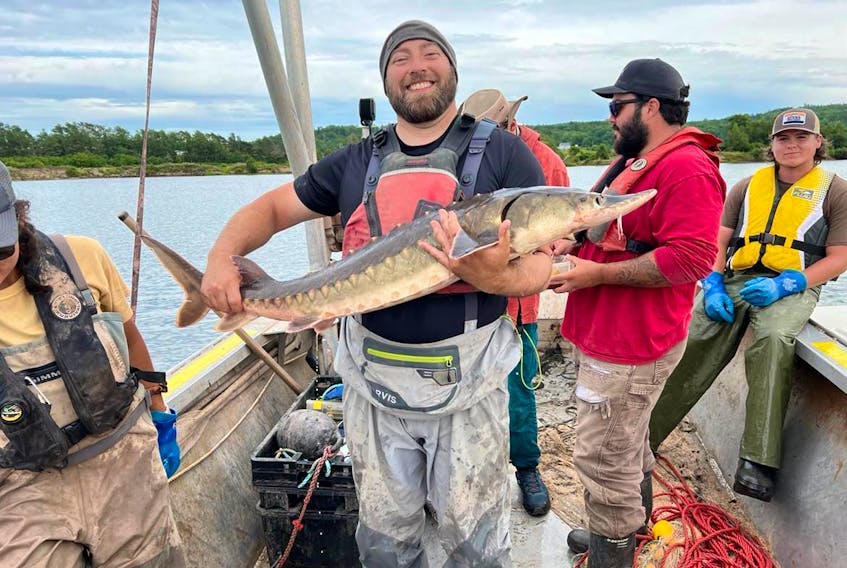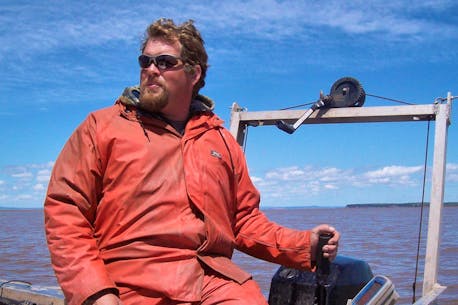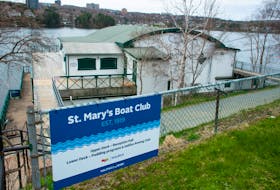Levi Cliché knew they were there.
Over the three years since the closure of Nova Scotia Power’s Annapolis Royal Generating Station, reports have been pouring in from anglers of massive primordial fish erupting from the water and slamming back down in the manner of humpback whales on the ocean.
The executive director of the Clean Annapolis River Project just didn’t know where to look along the 120-kilometre length of its run from the Caribou Bog, near Aylesford, down to its mouth at Port Royal.
So he and researchers from Acadia University brought in Darren Porter, a commercial fisherman who works with scientists in the Minas Basin, to find, catch and tag Atlantic sturgeon in the Annapolis River.

“We found way more than expected,” said Cliché of the three-day tagging program conducted on the river last weekend.
“We were hoping we might catch 10.”
Instead, they caught, tagged and released 21 sturgeon.
Proving the presence of sturgeon in the river matters.
Nova Scotia Power wants $27.7 million from ratepayers to cover the “undepreciated value” of the tidal generating station it says is broken.
In January the Nova Scotia Utility and Review Board refused to allow the power utility to begin collecting that money from ratepayers because it hadn’t put forward a plan to decommission the facility or shown that shutting it down is “the least cost alternative available.”
When it was operating the tidal turbine, Nova Scotia Power claimed it didn’t kill sturgeon despite decapitated sturgeon often being found downriver from the giant spinning blade they had to pass through to get below the causeway as the tide drained. Now the power corporation is helping to fund the survey that will also inform any renewed application to decommission the generating station.
“Nova Scotia Power was running a meat grinder in that river,” said Porter.
“After catching that many sturgeon that quickly, there’s zero chance in my opinion that that facility will be allowed to open again. It would need a Fisheries Act authorization, which would come with the requirement of offsetting the harm. How do you offset one of the most diverse rivers in the province?”
Even with the station gone there’s still a causeway across the river with gates that controls the water's flow. How the system is operated will (at least river advocates like Cliché hope they will) in part be dictated by the needs of species that live in the river.

“I’ve always been of the contention that they do spawn in the Annapolis River,” said Michael Dadswell, a semi-retired Acadia University professor.
According to Fisheries and Oceans Canada’s assessment and the Committee on the Status of Endangered Wildlife in Canada, the only breeding grounds for Atlantic sturgeon (which are listed as threatened) in this country are the Saint John and St. Lawrence rivers.
Over the three decades the turbine was running in the Annapolis River, mature females with what Dadswell calls "ripe" or ready-to-lay eggs would be found chopped in half downstream of the turbine at the height of spawning season.
Dadswell said he believes a few sturgeon were managing to get through the gates when they were opened to allow the rising tide through the causeway, enough to spawn up river and keep a population viable.
Going back down the river after spawning, many were likely killed as they and the rest of the river’s water were funneled through the turbine’s spinning blade.
The sturgeon’s unique lifecycle probably helped.
“After catching that many sturgeon that quickly, there’s zero chance in my opinion that that facility will be allowed to open again."
- Darren Porter, commercial fisherman
After hatching, they spend their first three years nosing around the muddy bottom of the river far upstream in freshwater. Sturgeon are like dustbusters; they suck up the muddy bottom through their barbed mouths, spraying out the dirt and rocks through their gills so that they can digest the worms and amphipods that make up their diet.
Then they move down the river for the next seven years where the saltwater mixes with the fresh and finally, at about 10 years old, they head out to sea. Males will stay out there for a decade, while females take 15 years before they return to their home river to spawn for the first time (males at 20 years old, females at 25).
They don’t have scales like other fish and have an armoured skeleton that makes them look like something out of a history textbook. Sturgeon can live to be upwards of 60 years old and weigh over 200 kilograms.
“The sturgeon have a 200-million-year history,” said Dadswell.
“There were sturgeon swimming up and down the rivers with the dinosaurs.”
Dadswell said the fish tagged last week were members of a migratory juvenile cohort travelling and feeding in rivers as they grow to reproductive age.
Ten of the fish were fitted acoustic tags, which will allow researchers to monitor their movement as they pass receivers spread out over the lower 40 kilometres of the river.
“We’re trying to look at habitat utilization by the sturgeon, timing of their migration, how they move throughout the (river) system, along with gathering some genetic information on their origin and what populations may be coming in,” said Cliché.
It still remains to be proven scientifically that they’re spawning in the Annapolis River, but Dadswell believes there are small populations spawning in rivers around the Bay of Fundy and further up the eastern seaboard. If proven, it would have potential ramifications for how we treat those rivers.
In the meantime, jumping sturgeon (which they do to help expel excess air from their swim-bladders) along with bigger striped bass runs are signs of how life can return to a river when we let it.
“You should see all the people out there fishing,” said Porter.
“They have their river back.”












